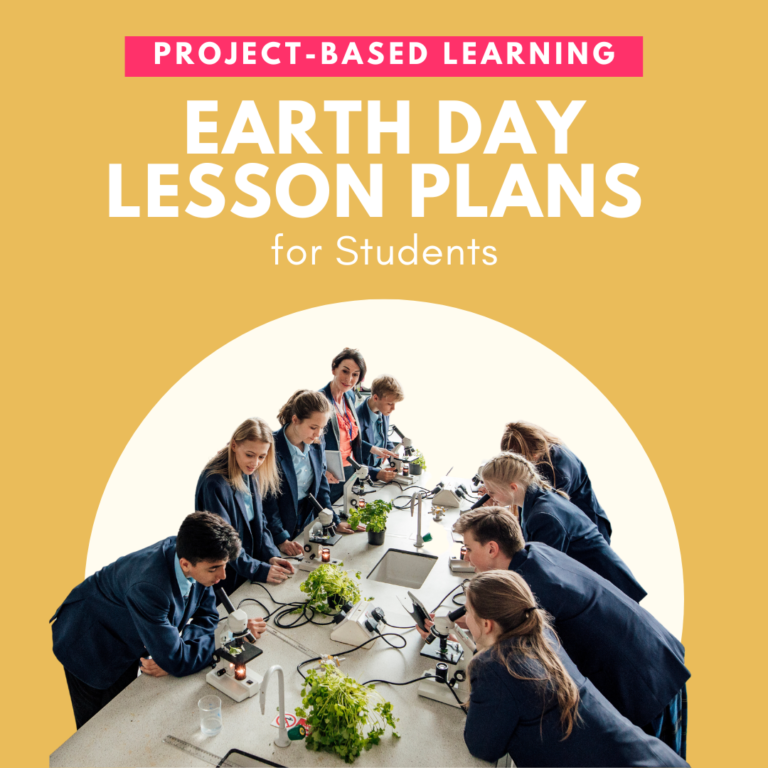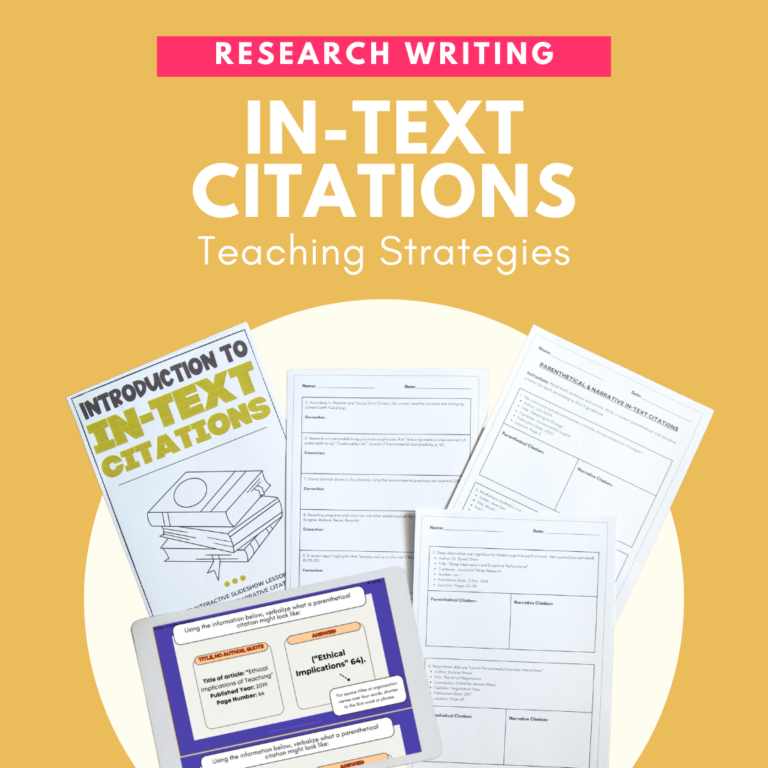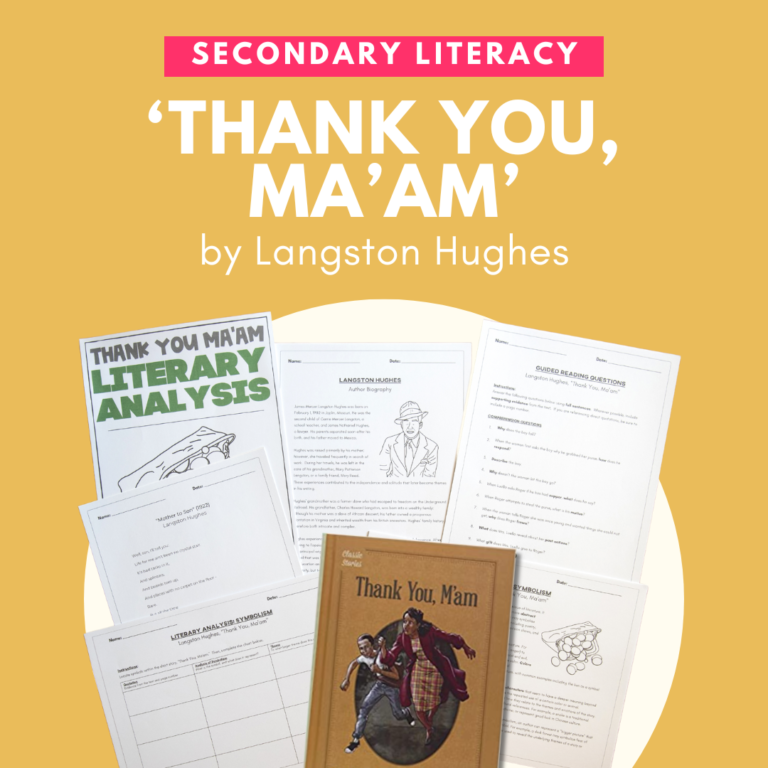You might recognize “project-based learning” as a buzzword in education. There is a reason for all the hype surrounding project-based learning. This style of instruction incorporates curriculum with 21st-century skills in a way that is highly engaging for students. If you’re looking for project-based learning ideas for the English Language Arts classroom, this blog post will introduce you to seven simple and fun project-based learning examples.
What is Project-Based Learning?
To put it simply, project-based learning delivers instruction through hands-on assessment. Students will meet the curriculum standards of the unit while they complete the project. The project will incorporate each learning goal by requiring students to reach the goal in order to solve the problem or finalize the project.
We tend to think about assessments as the final step of a learning path. Instead, project-based learning introduces the assessment near the beginning of a unit; to complete the assessment, students will be required to approach prerequisite learning goals.
You can assign project-based learning individually or as group work. I like to offer my students the opportunity to work on both types of projects over the course of the semester. I usually start with group PBL assignments. Then, I’ll challenge my students with an individual project-based learning assessment towards the end of the year. I find PBL most successful when I offer student-choice for individual project-based learning assignments.
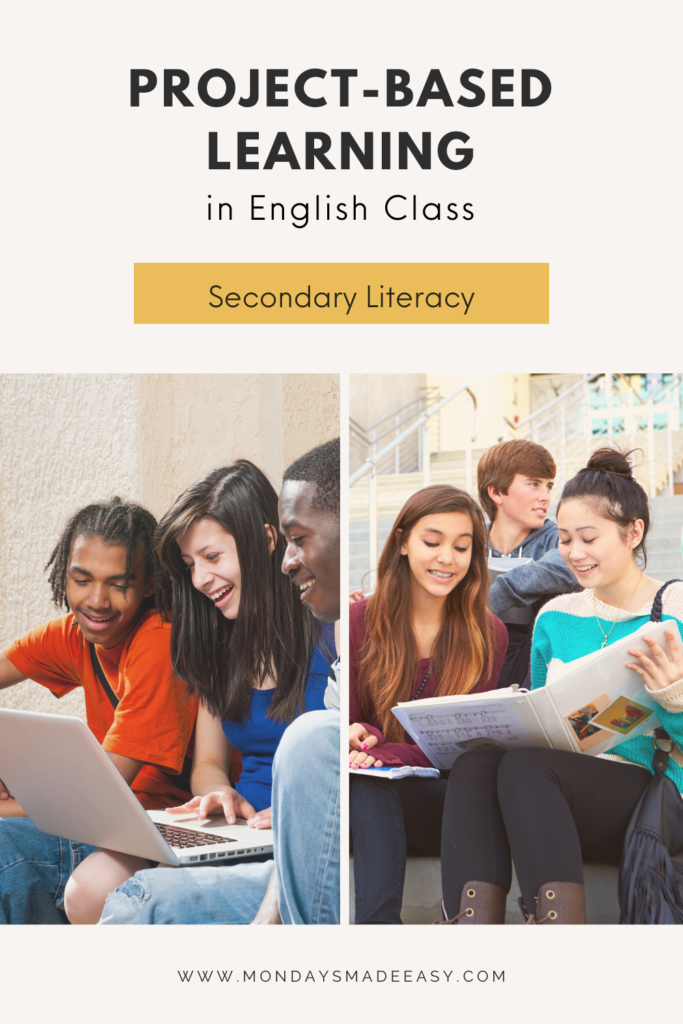
What are some examples of Project-Based Learning ideas?
Your colleagues may have implemented PBL in their classrooms, especially if they teach STEM subjects. Project-based learning ideas are often associated with technical or scientific design. When people think about PBL, they often think of projects like growing a garden, designing an app, or hatching a chicken egg.
The reality is that project-based learning ideas can apply to almost any activity that connects to the real world. If you’re an ELA teacher, you are probably already implementing real-world learning in some way. You can develop project-based learning ideas grounded in reading, writing, researching, speaking, and listening, like planning a vacation or conducting a mock trial!
Project-Based Learning Ideas for English
Here are some simple and fun project-based learning ideas for English. You can use these ideas in your ELA classroom even if you have no experience with PBL. You can also apply these ideas to middle school ELA and high school English classes:
Conduct a Mock Trial
Mock trials are one of the engaging project-based learning ideas where you can explore the legal system and teach argumentative writing. You can conduct a mock trial around any novel or short story that features a character that could be guilty of criminal negligence. Some examples can include Mary Maloney from Roald Dahl’s “Lamb to the Slaughter,” Mrs. Price from Sandra Cisneros’ “Eleven,” and Sanger Rainsford from “The Most Dangerous Game.”
Students will be motivated to dive deep into the text to look for evidence to support their arguments; in doing so, they will come to a greater understanding of the story’s underlying message and overarching themes. To prepare for a mock trial, you will need a central accusation along with mock trial roles to assign your students. This mock trial outline includes a slideshow lesson, 30+ role descriptions, an objections cheat sheet, a judge script, a universal rubric, and everything else you need to lead your students through this exciting project-based learning opportunity!
Plan a Vacation
Here is another one of the project-based learning ideas where learning opportunities are perfect for those long winter months! Have students plan a vacation – and practice various forms of writing while they’re at it! This type of project will invite students to explore the world without leaving the classroom.
Students can begin this project by thinking about a place they’d like to visit. The next steps are to use research skills to write an article about the local customs and culture. Students can then plan their daily itinerary and use graphic texts to illustrate their trip timeline or vacation budget. You can even have students practice narrative writing by crafting daily journal entries during their trip! This vacation planning project has everything you need to assign and assess this activity.
“Humans of My Community”
One of the project-based learning ideas that is popular in secondary school involves having students interview family members to explore their family tree; however, some students may require an approach to interviewing that is more trauma-informed. This is especially true for students’ families who have endured collective hardships or systemic oppression. I find “Humans of my Community” to be a perfect alternative. This project-based learning example uses the same interviewing skills listed above and incorporates news article writing – this is especially helpful if you are preparing for the OSSLT.
In addition to speaking and listening, students will need to learn the news article format in order to complete this project. In turn, they will better understand how to read and write news articles. Mondays Made Easy offers a Community Interview Project outline for high school students. This resource includes assignment instructions, graphic organizers for article writing, assessment guidelines, and tools to help students facilitate interviews.
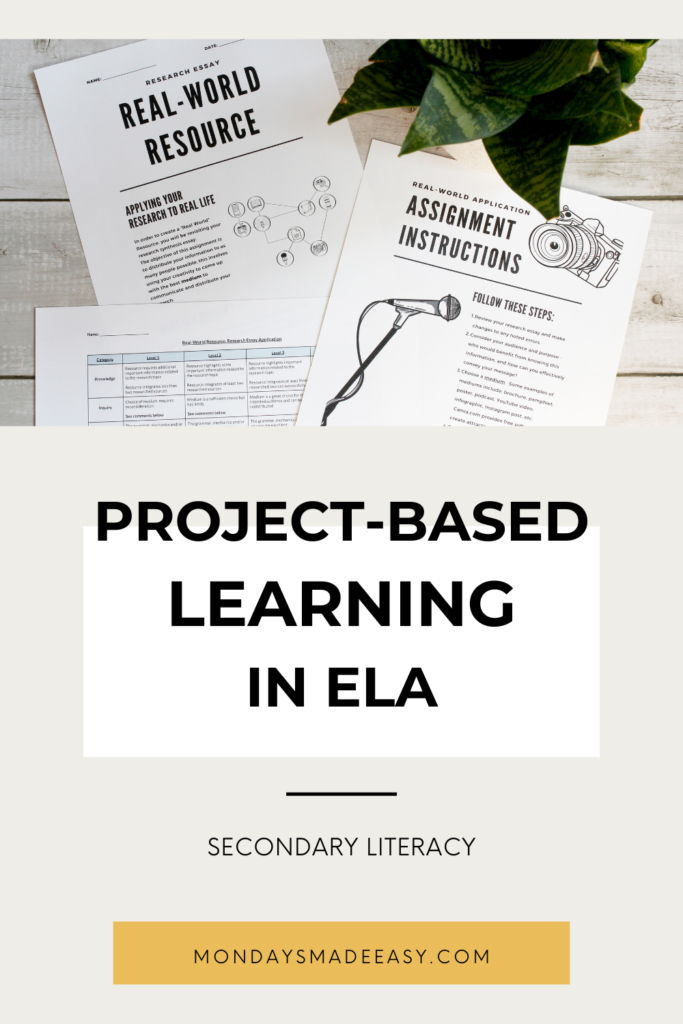
Letter Writing for Real-World Learning
Project-based learning ideas, like letter writing, are a great way to incorporate real-world learning into almost any novel study or short-story unit. You can do this by using backward design and starting with the major conflict or theme within the novel. Then, consider an organization in your community or geographic area that handles issues related to this topic. When you introduce the novel or short story, you can mention to students that they will write an appeal to this organization.
For example, when my students read I Am Malala, I introduced Amnesty International’s Write for Rights. I selected a person who reflected Malala’s situation in the novel and told students we will be writing and sending letters on their behalf. Students conducted their own research to develop arguments in their letters. Additionally, they applied the lessons and conversations from our novel study to further support the cases in their letters.
Real-World Resource for Research Essays
Project-based learning ideas, such as using real-world resources, can spice up a research unit. A real-world resource can be any medium used to deliver information to the public. Examples include pamphlets, TED Talks, infographics, podcasts, and more. This project-based learning idea is a great opportunity for implementing student choice. Students can select a topic of interest to them to inform their audience.
Of course, in order to inform, students will need to research. You can incorporate teaching MLA format, practicing in-text citations, and other important research skills related to your English Language Arts curriculum. The best part about this PBL assignment is that it shows students the value of research in the real world. Your students will see the parallel between expository and argumentative writing and fields including marketing, broadcasting, media production, hospitality, medicine, health and wellness, and more!
Mondays Made Easy offers a Real-World Resource assignment outline that includes instructions, assessment tools, and student examples. You can use this resource to facilitate this project-based learning idea in your classroom.
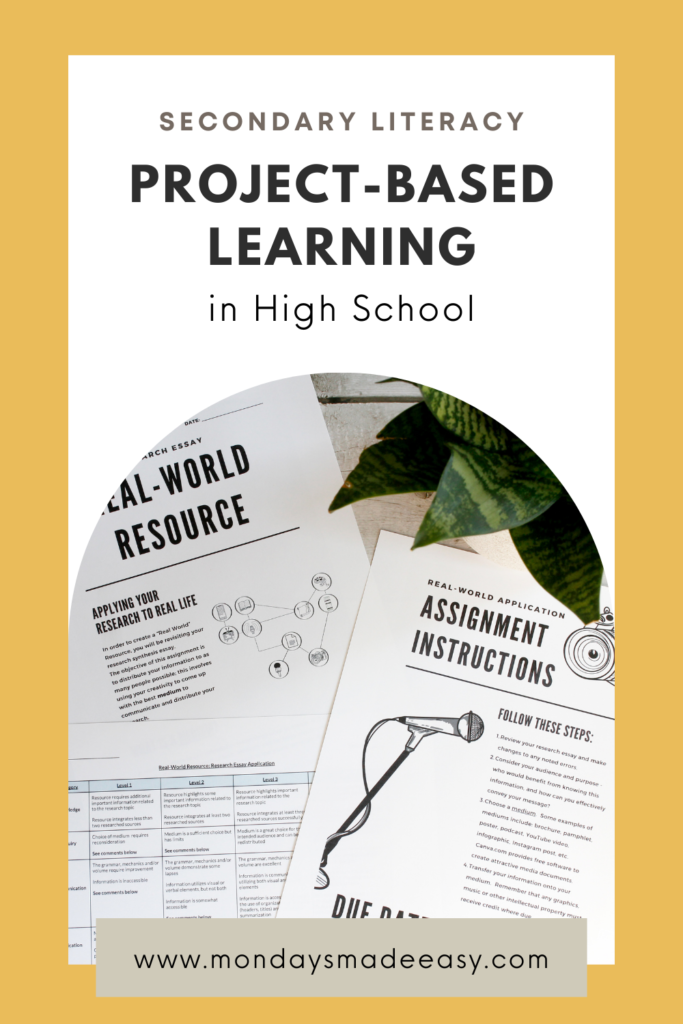
Fundraising as a Project-Based Learning Idea
Here’s another one of the project-based learning ideas that you can connect to any novel study or short-story unit. Similar to letter-writing, students can actively apply the story’s conflict and themes to real-world scenarios. You can select a community partnership that supports a cause related to the story you are studying in class.
Students can apply their knowledge of the text to their fundraising initiatives by selecting items of need for fundraising. Additionally, students will need to demonstrate that they are well-versed in their topic to appeal to donors.
I used the following example in my classroom: while we were reading Nancy Mair’s “On Being a Cripple” in my AP Language and Composition class, my students gained an understanding of what it meant to be able-bodied. Then, they invited a local organization supporting students with disabilities to join a fundraising event at our school.
This partnership required students to meet cross-curricular requirements involving letter-writing, event planning, and managing funds. In addition, students gained compassion and understanding for people who are disabled – an important real-world lesson for students attending school in the private sector.
Classroom Debates
You can bring your persuasive writing unit alive by assigning a classroom debate—one of the project-based learning ideas that is always a huge hit. Students can begin this assignment by brainstorming different topics of interest. Then, you can assign teams based on student choice.
In order to develop a strong argument, students will need to learn how to develop main points and supporting evidence. They will also learn the value of different types of evidence. Finally, they will practice public speaking and listening as they present their arguments and rebuttals.
Mondays Made Easy offers a Lincoln-Douglas Debate resource that outlines the structure of this classic form of debate. This resource also provides students with graphic organizers to develop their ideas. Additionally, you will receive a moderator script in order to easily facilitate a classroom debate.
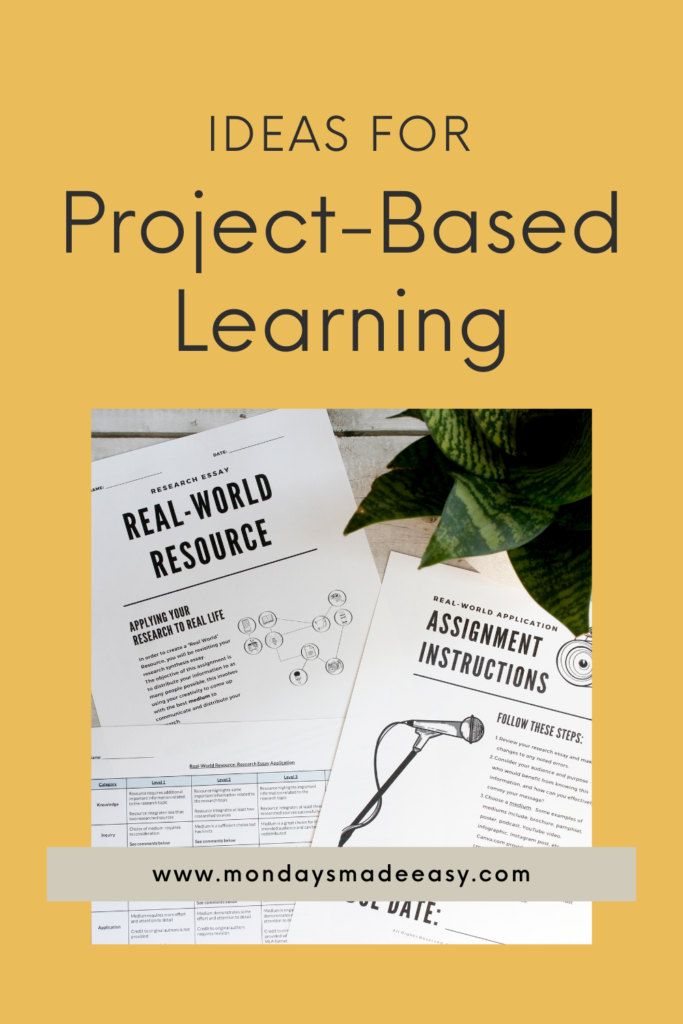
Tying it all Together
Project-based learning ideas are not exclusive to STEM subjects. If you’ve been avoiding PBL in your classroom or have not been sure where to start, I promise you’re going to love it! Your students will also enjoy the project-based learning examples featured in this blog post and remember them for years to come.

